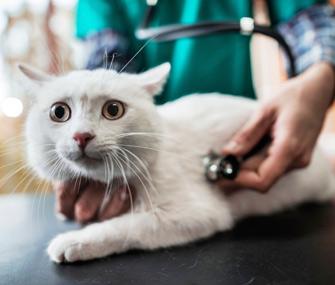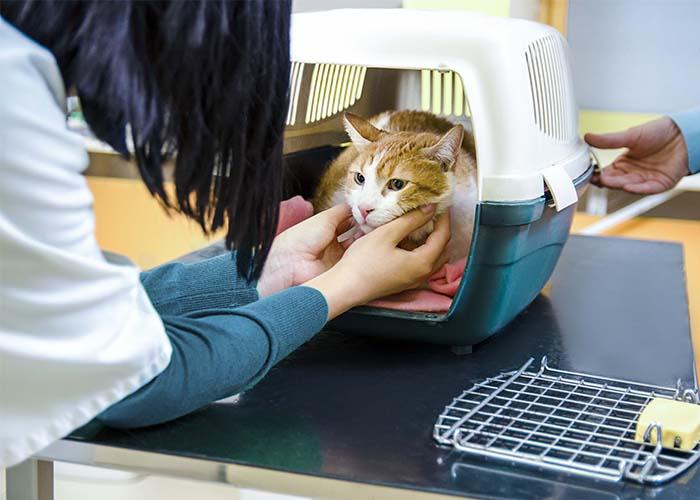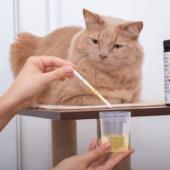Veterinary visits - minimising stress

Visiting the veterinarian can be a source of stress for both cats and their owners. However, it is a crucial aspect of maintaining your feline companion's health and well-being. In this article, we will explore ways to reduce anxiety and make veterinary visits a more positive experience for your cat.
Veterinary visits - minimising stress
Going to the vet's office is a very stressful experience for cats. They often show signs of worry from the time they are put in the carrier until they receive their medicine. When cats are scared, they often freeze or lie still. This means that you might not notice that they are scared, so it is important to learn how to make the trip to the vet as fun as possible and know how to spot the signs of stress.

How do I know if my cat is stressed or anxious?
Every step of going to the vet can cause fear for your cat. It is even worse for indoor cats who never leave their home. From being put in a carrier, to entering the vet practice, moving from waiting room to examination room, being weighed to being examined, pets can find every stage stressful.
Owners usually recognise that their pet does not like to go to the vet but the physical and behavioural signs of stress, distress and anxiety may be ignored because they are considered ‘normal’.
While most people recognise shaking or trembling as signs of anxiety and distress, they might not recognise the following signs:
- Social withdrawal with or without complete freezing
- Physical freezing and rigidity
- Salivation and/or clear nasal discharge
- Shaking/tremor
- Increased shedding of hair/exfoliation of dry skin
- Avoidance of stimulus that triggers response, eg metal table, flooring that isn’t non-slip
- Vocalisation, eg hissing, whimpering
- Dilated eyes
- Escape behaviours
- Grabbing with mouth or paws
- Yawning/licking lips
- Scratching
- Hiding, crouching, low body posture
- Tucking tail
- Panting, fast heart rate and breathing, hyperthermia
- Increased or decreased pain sensitivity
- Increased or decreased reactivity to touch or approach
- Exacerbation of any cardiac, respiratory or skeletal condition
- Urination and/or defaecation in the carrier.
-

How can I prepare my cat for the vet examination?
Choosing the Right Carrier
-
Size and Accessibility:
- Select a carrier that is large enough for your cat to comfortably stand, turn around, and lie down in. It should also have a secure latch and be easy to open from the top and front.
-
Bedding and Familiar Items:
- Add a soft bedding or towel inside the carrier and include familiar items like a favorite toy or blanket.
Getting your cat used to being in a carrier
Cats need to learn how to use a cage. There should be enough air flow in the carrier for a thick towel and the cat to stand up. It should also be easy to clean and have a hard floor.You can put any cat's favorite toys in the box as well. Do this often so the cat doesn't get scared of it. Once your cat is used to going into and staying in the carrier to sleep, eat, or play, close the door and let them stay inside for longer and longer amounts of time. Any scared animal can get stuck in a closed cage, so make sure the cat is never upset.
Pick up the carrier and move it around once your cat is used to going in and out of it and can stay in a closed carrier without getting upset. Leave it for different amounts of time and in different places. Your cat shouldn't be stressed out by this if you do it slowly.
Finally, pick up and leave the carrier with a towel over it. Take the carrier and cat indoors and outdoors, covered and uncovered, working with the cat’s tolerance and distress levels. If the cat must go into a car, you will need to learn how to secure the carrier without the cat in it first.
If you still have problems getting your cat used to being transported in a carrier, ask your vet to recommend a specialist who can help.
Regular Handling and Desensitization:
Gently handle your cat's paws, ears, and mouth to help them become accustomed to being touched, which is common during veterinary exams.
Getting into the veterinary practice reception and waiting room
Now to get the cat into the veterinary practice! Ask if your vet has a cat-friendly approach, ie has separate dog and cat waiting rooms, consultation rooms etc. Cat-friendly clinics can be found at www.catfriendlyclinic.org
If your cat suffers from motion sickness from the journey, check for any signs of nausea, salivation or wooziness. Your cat may benefit from mild sedation or anti-emetic medication for travel sickness before the next visit.
In some places, there are scales in the waiting room. For big cats, it's fine to weigh them in the carrier. The staff can write down later how much the carrier weighs. Just put a small cat on the scale and wrap it in a towel. Then weigh the towel instead. A lot of hospitals have "baby scales" that can be used to weigh cats while they are being checked out. Cats will often walk right on the scale once they get used to it. Call the vet's office ahead of time to find out if they can take your cat right into the exam room or if you and your cat can wait in the car until the room is ready.
How can the visit to the vets be made less stressful?
Fear worsens with time so early appointments should involve treats, play, massage and lots of fun activities before anything threatening is attempted, eg vaccinations. Kitten visits should therefore be longer and pets should be allowed to interact with the staff and explore the surgery. On-site kitten classes are excellent for this.
The Day of the Veterinary Visit
-
Pheromone Sprays or Wipes:
- Use feline calming pheromone sprays or wipes on the carrier and bedding to create a calming environment.
-
Cover the Carrier:
- Place a towel or blanket over the carrier to provide a sense of security and block out potentially stressful sights.
-
Stay Calm and Relaxed:
- Cats can pick up on their owner's emotions. Staying calm and speaking in a soothing tone can help reassure your cat.
During the Veterinary Visit
-
Quiet Waiting Area:
- If possible, choose appointment times when the waiting area is less crowded and noisy.
-
Inform the Veterinarian:
- Let the vet and their staff know if your cat is anxious or has had previous stressful experiences at the clinic.

After the Visit
-
Reinforce Positive Associations:
- Offer treats, playtime, or cuddles after returning home to create positive memories associated with the visit.
-
Monitor for Changes in Behavior:
- Keep an eye on your cat for any signs of stress or discomfort after the visit. Contact your veterinarian if you have concerns.
Minimizing stress during veterinary visits is important for the overall well-being of your cat. By taking proactive steps at home, choosing the right carrier, and creating a calming environment, you can help your feline companion feel more comfortable and secure during their appointments. Remember, a positive veterinary experience contributes to a healthier, happier cat.





